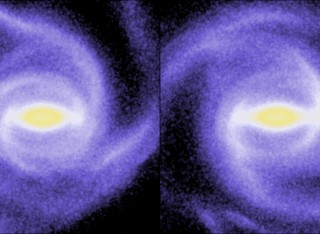
Dr Tariq Hilmi
About
My research project
A census of Milky Way subhaloes with stellar streamsI study the effects that both baryonic structure in the disk (such as our spiral arms and galactic bar) and dark matter substructure have on the tracks of stellar streams.
I study the effects that both baryonic structure in the disk (such as our spiral arms and galactic bar) and dark matter substructure have on the tracks of stellar streams.
Publications
We present the first spectroscopic measurements of the ATLAS and Aliqa Uma streams from the Southern Stellar Stream Spectroscopic Survey (S (5)), in combination with the photometric data from the Dark Energy Survey and astrometric data from Gaia. From the coherence of spectroscopic members in radial velocity and proper motion, we find that these two systems are extremely likely to be one stream with discontinuity in morphology and density on the sky (the "kink" feature). We refer to this entire stream as the ATLAS-Aliqa Uma stream, or the AAU stream. We perform a comprehensive exploration of the effect of baryonic substructures and find that only an encounter with the Sagittarius dwarf similar to 0.5 Gyr ago can create a feature similar to the observed "kink." In addition, we also identify two gaps in the ATLAS component associated with the broadening in the stream width (the "broadening" feature). These gaps have likely been created by small mass perturbers, such as dark matter halos, as the AAU stream is the most distant cold stream known with severe variations in both the stream surface density and the stream track on the sky. With the stream track, stream distance, and kinematic information, we determine the orbit of the AAU stream and find that it has been affected by the Large Magellanic Cloud, resulting in a misalignment between the proper motion and stream track. Together with the Orphan-Chenab Stream, AAU is the second stream pair that has been found to be a single stream separated into two segments by external perturbation.
It has recently been shown that the Large Magellanic Cloud (LMC) has a substantial effect on the Milky Way's stellar halo and stellar streams. Here, we explore how deformations of the Milky Way and LMC's dark matter haloes affect stellar streams, and whether these effects are observable. In particular, we focus on the Orphan-Chenab (OC) stream which passes particularly close to the LMC and spans a large portion of the Milky Way's halo. We represent the Milky Way–LMC system using basis function expansions that capture their evolution in an-body simulation. We present the properties of this system, such as the evolution of the densities and force fields of each galaxy. The OC stream is evolved in this time-dependent, deforming potential, and we investigate the effects of the various moments of the Milky Way and the LMC. We find that the simulated OC stream is strongly influenced by the deformations of both the Milky Way and the LMC and that this effect is much larger than current observational errors. In particular, the Milky Way dipole has the biggest impact on the stream, followed by the evolution of the LMC's monopole, and the LMC's quadrupole. Detecting these effects would confirm a key prediction of collisionless, cold dark matter, and would be a powerful test of alternative dark matter and alternative gravity models.
We study the late-time evolution of the central regions of two Milky Way (MW)-like simulations of galaxies formed in a cosmological context, one hosting a fast bar and the other a slow one. We find that bar length, R-b, measurements fluctuate on a dynamical time-scale by up to 100 per cent, depending on the spiral structure strength and measurement threshold. The bar amplitude oscillates by about 15 per cent, correlating with Rb. The Tremaine-Weinberg method estimates of the bars' instantaneous pattern speeds show variations around the mean of up to similar to 20 per cent, typically anticorrelating with the bar length and strength. Through power spectrum analyses, we establish that these bar pulsations, with a period in the range similar to 60-200 Myr, result from its interaction with multiple spiral modes, which are coupled with the bar. Because of the presence of odd spiral modes, the two bar halves typically do not connect at exactly the same time to a spiral arm, and their individual lengths can be significantly offset. We estimated that in about 50 per cent of bar measurements in MW-mass external galaxies, the bar lengths of SBab-type galaxies are overestimated by similar to 15 per cent and those of SBbc types by similar to 55 per cent. Consequently, bars longer than their corotation radius reported in the literature, dubbed 'ultrafast bars', may simply correspond to the largest biases. Given that the Scutum-Centaurus arm is likely connected to the near half of the MW bar, recent direct measurements may be overestimating its length by 1-1.5 kpc, while its present pattern speed may be 5-10 km s(-1) kpc(-1) smaller than its time-averaged value.
